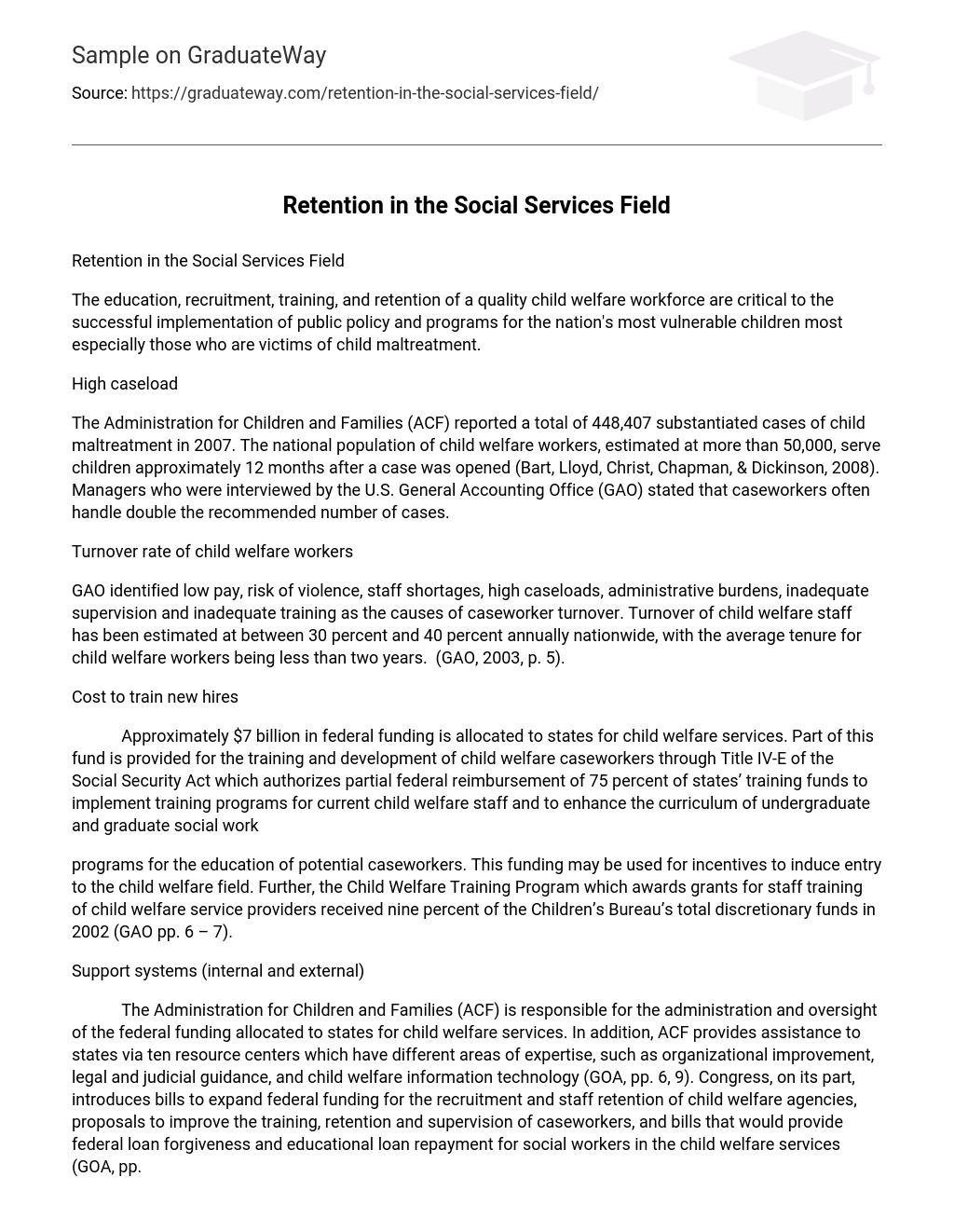The education, recruitment, training, and retention of a quality child welfare workforce are critical to the successful implementation of public policy and programs for the nation’s most vulnerable children most especially those who are victims of child maltreatment.
High caseload
The Administration for Children and Families (ACF) reported a total of 448,407 substantiated cases of child maltreatment in 2007. The national population of child welfare workers, estimated at more than 50,000, serve children approximately 12 months after a case was opened (Bart, Lloyd, Christ, Chapman, ; Dickinson, 2008). Managers who were interviewed by the U.S. General Accounting Office (GAO) stated that caseworkers often handle double the recommended number of cases.
Turnover rate of child welfare workers
GAO identified low pay, risk of violence, staff shortages, high caseloads, administrative burdens, inadequate supervision and inadequate training as the causes of caseworker turnover. Turnover of child welfare staff has been estimated at between 30 percent and 40 percent annually nationwide, with the average tenure for child welfare workers being less than two years. (GAO, 2003, p. 5).
Cost to train new hires
Approximately $7 billion in federal funding is allocated to states for child welfare services. Part of this fund is provided for the training and development of child welfare caseworkers through Title IV-E of the Social Security Act which authorizes partial federal reimbursement of 75 percent of states’ training funds to implement training programs for current child welfare staff and to enhance the curriculum of undergraduate and graduate social work
programs for the education of potential caseworkers. This funding may be used for incentives to induce entry to the child welfare field. Further, the Child Welfare Training Program which awards grants for staff training of child welfare service providers received nine percent of the Children’s Bureau’s total discretionary funds in 2002 (GAO pp. 6 – 7).
Support systems (internal and external)
The Administration for Children and Families (ACF) is responsible for the administration and oversight of the federal funding allocated to states for child welfare services. In addition, ACF provides assistance to states via ten resource centers which have different areas of expertise, such as organizational improvement, legal and judicial guidance, and child welfare information technology (GOA, pp. 6, 9). Congress, on its part, introduces bills to expand federal funding for the recruitment and staff retention of child welfare agencies, proposals to improve the training, retention and supervision of caseworkers, and bills that would provide federal loan forgiveness and educational loan repayment for social workers in the child welfare services (GOA, pp. 10 – 11). Child welfare agencies and universities also collaborate by offering Bachelor’s of Social Work (BSW) and Master’s of Social Work (MSW) programs.
References
Administration for Children and Families (2007). Child maltreatment 2007. Retrieved July 8, 2009, from: http://www.acf.hhs.gov/programs/cb/pubs/cm07/table2_3.htm
Balfour, D.L. ; Neff, D.M. (1993). Predicting and managing turnover in human service
agencies: a case study of an organization in crisis. Public Personnel Management, 22(3), 473-486.
Bart, R.R., Lloyd, E.C., Christ, S.L., Chapman, M.V. ; Dickinson, N.S. (2008). Child welfare
workers characteristics and job satisfaction: a national study. National Association of Social Workers (NASW), 53(3), 99-209.
U.S. General Accounting Office. (2003, March). HHS (Human and Health Services) could play
a greater role in helping child welfare agencies recruit and retain staff. (Publication No. GAO-03-357). Retrieved June 21, 2009 from: http://www.gao.gov/new.items/d03357.pdf
;





